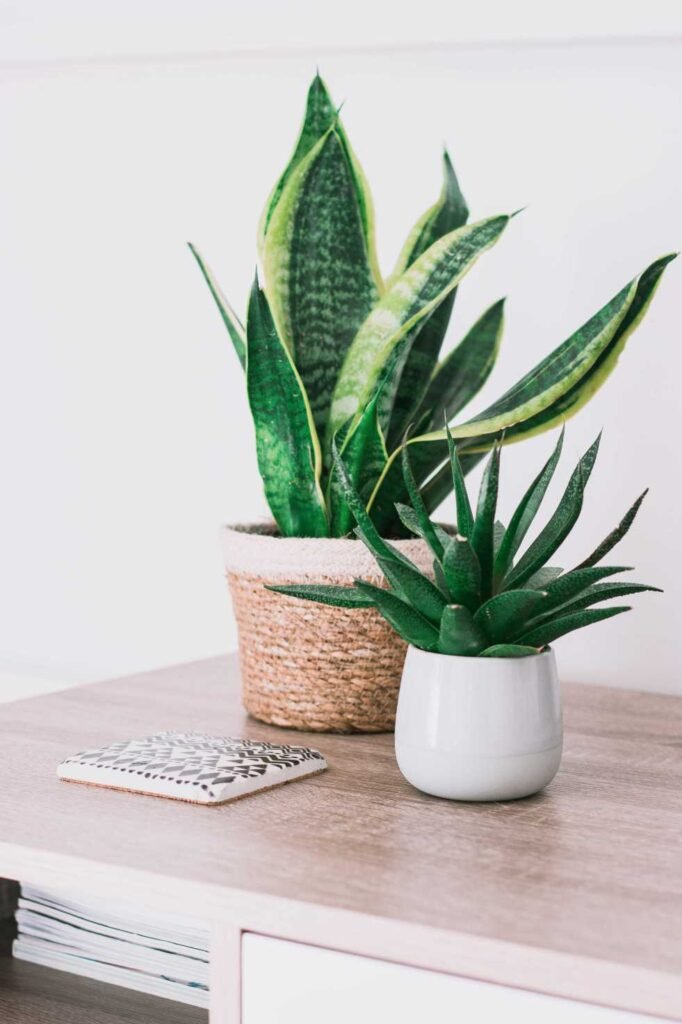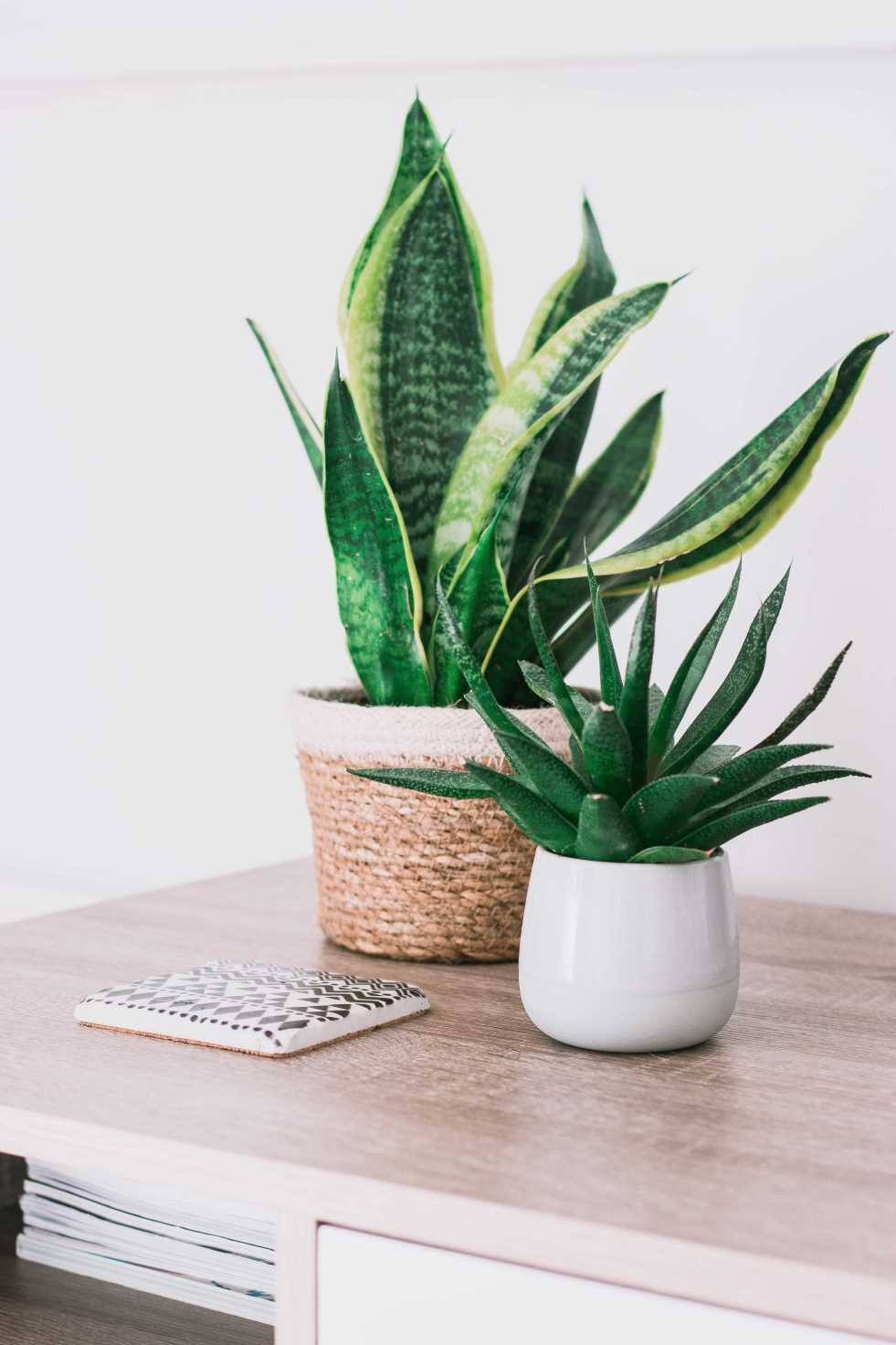Snake plants (Sansevieria), also known as “mother-in-law’s tongue,” are one of the most popular houseplants due to their striking appearance, air-purifying qualities, and ease of care.
These hardy plants are incredibly resilient and can thrive in a variety of environments, making them an excellent choice for both seasoned gardeners and beginners.
In this detailed guide, we will explore everything you need to know about how to take care of a snake plant. We will cover a wide range of topics, from understanding the plant’s origins and benefits to providing tips on proper watering, lighting, and more.
By the end of this guide, you’ll have all the knowledge you need to grow and maintain a healthy, vibrant snake plant.

Table of Contents
Introduction to Snake Plants
Snake plants belong to the genus Sansevieria, which comprises around 70 species of flowering plants, native to Africa, Madagascar, and southern Asia.
The plant’s most common name, snake plant, comes from the shape of its long, upright leaves, which resemble the body of a snake. Another common name, “mother-in-law’s tongue,” refers to the plant’s sharp, pointed leaves.
These plants are popular not only for their distinctive look but also because they are incredibly low-maintenance. Snake plants are renowned for their ability to survive in low light and with minimal water, making them a go-to plant for anyone who doesn’t have a green thumb.
Benefits of Owning a Snake Plant
Snake plants offer more than just aesthetic appeal. They come with a range of benefits that make them a valuable addition to any home or office. Let’s explore some of these benefits in detail:
1. Air-Purifying Qualities
One of the most well-known benefits of snake plants is their ability to purify the air. According to a study conducted by NASA, snake plants can remove toxins such as formaldehyde, benzene, xylene, and toluene from the air. This makes them excellent plants for improving indoor air quality.
2. Easy Maintenance
Unlike some houseplants that require constant care, snake plants are incredibly easy to maintain. They can thrive in a variety of conditions, tolerate low light, and can go for weeks without water. This makes them ideal for busy individuals or those who may forget to water their plants regularly.
3. Versatility
Snake plants come in different varieties, shapes, and sizes, making them highly versatile in terms of design. Whether you need a small plant for your desk or a tall one to fill a corner, there’s a snake plant variety to suit your space.
4. Boosts Humidity Levels
Snake plants can help maintain indoor humidity levels. By releasing moisture into the air through a process called transpiration, snake plants contribute to reducing dryness in the environment, which is particularly beneficial in air-conditioned or heated spaces.
5. Low Allergen Plant
For those sensitive to pollen or plants with heavy fragrances, snake plants are a great option. They produce oxygen without triggering common allergic reactions, making them safe for allergy sufferers.
Understanding the Different Varieties of Snake Plants
Before diving into care instructions, it’s helpful to understand the various types of snake plants available. Each variety has slight differences in appearance, growth patterns, and size. Here are some popular varieties:
- Sansevieria trifasciata ‘Laurentii’: One of the most recognizable varieties, with green leaves edged in yellow stripes.
- Sansevieria cylindrica: Characterized by its round, tubular leaves that grow upright and resemble a collection of spears.
- Sansevieria trifasciata ‘Moonshine’: Known for its striking silver-green leaves that are wider and shorter than other varieties.
- Sansevieria ‘Black Gold’: This variety has deep green leaves with bright yellow margins, creating a striking contrast.
- Sansevieria ‘Twisted Sister’: A compact variety with twisted leaves that give it a more playful, unique look.
How to Care for a Snake Plant
Caring for a snake plant is relatively straightforward, but there are some important aspects to consider to ensure your plant remains healthy and vibrant. Below is a breakdown of the key elements of snake plant care.
1. Choosing the Right Pot and Soil
Snake plants are susceptible to root rot, so it’s essential to select a pot with drainage holes to prevent water from pooling at the bottom. Terracotta or clay pots are ideal as they allow excess moisture to evaporate more easily.
As for soil, snake plants thrive in well-draining soil mixes. A succulent or cactus potting mix is ideal, as it mimics the plant’s native, arid environment. You can also make your own mix by combining regular potting soil with sand or perlite to improve drainage.
2. Watering Requirements
One of the most common mistakes when caring for snake plants is overwatering. These plants are adapted to survive in dry conditions and don’t require frequent watering. A general rule of thumb is to water the plant when the top 1-2 inches of soil are completely dry. In the winter months, snake plants may need even less water, as they enter a dormant phase.
To avoid root rot, it’s important to water the plant sparingly and ensure excess water drains out of the pot. Always err on the side of underwatering rather than overwatering, as snake plants are highly drought-tolerant.
3. Lighting Conditions
Snake plants are incredibly adaptable when it comes to lighting. They can tolerate low-light conditions, making them an excellent choice for indoor spaces with minimal natural light. However, they thrive in bright, indirect sunlight. Exposure to more light will encourage faster growth and more vibrant colors in the leaves.
Avoid placing your snake plant in direct sunlight, as this can cause the leaves to burn. A spot near a north or east-facing window is ideal.
4. Humidity and Temperature
Snake plants are highly tolerant of different humidity levels, which makes them well-suited for both dry and humid environments. However, they prefer average humidity levels (around 40-50%).
In terms of temperature, snake plants are not frost-hardy and should be kept in environments where temperatures range between 55-85°F (13-29°C). Avoid placing the plant near cold drafts or air conditioners, as extreme temperature fluctuations can cause stress to the plant.
5. Fertilizing Your Snake Plant
Snake plants don’t require heavy feeding, but they can benefit from occasional fertilizing, especially during their active growing season in the spring and summer. Use a balanced liquid fertilizer diluted to half-strength once a month. Avoid over-fertilizing, as this can lead to salt build-up in the soil, which may harm the plant.
During the fall and winter months, when the plant enters dormancy, it’s best to stop fertilizing altogether.
6. Repotting Your Snake Plant
Snake plants are slow growers, so they don’t need to be repotted frequently. However, if your plant becomes root-bound, you may notice the roots pushing up from the soil or the plant becoming top-heavy. In this case, it’s time to repot.
Choose a pot that is slightly larger than the current one, and ensure it has good drainage. Repotting is best done in the spring, just before the plant enters its growing phase.
7. Pest Control
Snake plants are relatively resistant to pests, but they can occasionally be affected by mealybugs, spider mites, or scale insects. These pests feed on the plant’s sap, causing yellowing or wilting leaves.
To combat pests, wipe the affected areas with a cloth dipped in soapy water or a diluted solution of rubbing alcohol. In severe cases, you may need to use an insecticidal soap or neem oil spray.
Common Issues with Snake Plants and How to Solve Them
Despite their hardy nature, snake plants can occasionally encounter problems. Here are some common issues and how to address them:
1. Yellowing Leaves
Yellowing leaves are often a sign of overwatering. If your snake plant’s leaves are turning yellow, check the soil for moisture and ensure it is not waterlogged. Allow the soil to dry out completely before watering again.
2. Brown Tips
Brown leaf tips can be caused by underwatering, low humidity, or excessive exposure to direct sunlight. Make sure you’re watering the plant appropriately and that it’s not placed in direct sunlight.
3. Root Rot
Root rot is one of the most common issues with snake plants and is caused by overwatering. If you notice soft, mushy roots or a foul odor, remove the plant from its pot, cut away the affected roots, and repot it in fresh, dry soil.
Propagating Snake Plants
One of the best things about snake plants is how easy they are to propagate. There are several methods you can use to propagate a snake plant:
1. Division
The simplest way to propagate a snake plant is by division. When your plant has grown large enough, you can divide it into smaller sections by cutting through the root ball. Each section should have at least one healthy leaf and a portion of the root system.
2. Leaf Cuttings
You can also propagate snake plants through leaf cuttings. Cut a healthy leaf into 3-4 inch sections, and allow the cut ends to callous over for a day or two. Then, place the cuttings in a well-draining soil mix, ensuring that the cut end is facing down. Keep the soil lightly moist until roots develop.
Frequently Asked Questions
Q: Can snake plants grow in low light?
A: Yes, snake plants are very tolerant of low light conditions, although they grow more slowly in such environments. For best results, place them in bright, indirect light.
Q: How often should I water my snake plant?
A: Water your snake plant when the top 1-2 inches of soil are dry. This typically means watering once every 2-3 weeks, but it may vary based on your home’s humidity and temperature.
Q: Do snake plants improve indoor air quality?
A: Yes, snake plants are excellent at purifying the air by removing toxins such as formaldehyde, benzene, and xylene.
Q: How long can a snake plant live?
A: Snake plants are long-lived houseplants that can survive for many years, often between 5 to 25 years or more with proper care. In some cases, they can last even longer if they are consistently well-maintained. Regular care such as occasional repotting and correct watering can extend the plant’s lifespan significantly.
Q: Is a snake plant toxic to pets?
A: Yes, snake plants are mildly toxic to pets, particularly cats and dogs. If ingested, they can cause symptoms such as nausea, vomiting, and diarrhea due to the presence of saponins, a natural chemical found in the plant. It’s best to keep snake plants out of reach of pets to avoid accidental ingestion.
Q: Can snake plants tolerate artificial light?
A: Yes, snake plants can tolerate artificial light, making them suitable for indoor environments like offices with little to no natural sunlight. However, they will grow best when exposed to some indirect natural light. If you’re relying solely on artificial light, make sure it’s fluorescent or LED light that mimics daylight, as this will provide the plant with the energy it needs for photosynthesis.
Q: Why are my snake plant’s leaves curling?
A: Curling leaves can be caused by a variety of factors. The most common reasons include:
- Underwatering, which causes the plant to dehydrate and the leaves to curl inward to conserve moisture.
- Pests, such as spider mites or thrips, can damage the leaves and cause curling.
- Excessive direct sunlight, which can cause the leaves to overheat and curl. Check your watering habits, inspect for pests, and assess the lighting conditions to resolve the issue.
Q: Can I grow a snake plant outdoors?
A: Snake plants can be grown outdoors in regions where the climate is warm enough year-round. They thrive in USDA hardiness zones 9-11, which means they can tolerate outdoor conditions in areas that don’t experience frost or freezing temperatures. If you live in a cooler region, snake plants can be placed outside during the warmer months but should be brought indoors when temperatures drop below 50°F (10°C).
Q: How can I tell if my snake plant is root-bound?
A: Snake plants are slow growers, so they don’t need frequent repotting, but they can become root-bound over time. Signs of a root-bound snake plant include:
- Roots growing out of the drainage holes.
- The plant becoming top-heavy or leaning.
- Difficulty watering because the soil no longer absorbs water effectively. If you notice these signs, it’s time to repot the plant into a larger container with fresh soil.
Q: What should I do if my snake plant’s leaves are drooping?
A: Drooping leaves can indicate several potential problems:
- Overwatering, which can lead to root rot and weak, droopy leaves.
- Underwatering, causing the plant to lose turgor pressure in the leaves.
- Cold drafts or sudden temperature changes that shock the plant. To address drooping leaves, check your watering schedule and ensure the plant isn’t exposed to cold air or sudden temperature fluctuations.
Q: How fast do snake plants grow?
A: Snake plants are relatively slow-growing, especially in low-light conditions. However, they tend to grow more quickly when provided with bright, indirect sunlight. On average, you can expect new leaves to emerge during the plant’s active growing season (spring and summer). Growth slows down during the fall and winter when the plant goes dormant.
Q: Can I prune my snake plant?
A: Yes, you can prune your snake plant if it becomes too large or if you want to remove damaged or unsightly leaves. Pruning is best done in the spring or summer. Simply cut the leaves at the base with a clean, sharp knife or scissors. Pruning won’t harm the plant and can help it look more neat and tidy.
Q: Can snake plants grow in water?
A: Yes, snake plants can be grown in water, a method known as hydroponic growth. To grow a snake plant in water, place a leaf cutting or the root base in a container filled with water, ensuring that only the roots (or bottom of the leaf cutting) are submerged. Change the water every couple of weeks to prevent stagnation and ensure healthy root development. However, long-term growth in soil is generally healthier for the plant.
Q: Should I mist my snake plant?
A: Snake plants are native to dry, arid environments and don’t require misting. In fact, too much humidity can cause issues like fungal growth. If your home has extremely dry air, you can occasionally mist the plant, but this is not necessary for its health. It’s more important to ensure the soil remains dry between waterings than to focus on misting.
Q: Why does my snake plant have dark spots on its leaves?
A: Dark or black spots on the leaves of a snake plant are typically a sign of overwatering or fungal infection. Overwatering can lead to root rot, which spreads to the leaves and causes dark spots. To prevent this, make sure the plant is not sitting in water, and always allow the soil to dry out between waterings. You can also trim off any affected leaves to prevent the spread of the fungus.
Q: What type of pot is best for a snake plant?
A: The best pot for a snake plant is one with drainage holes to prevent water from pooling at the bottom, which can lead to root rot. Terracotta or clay pots are ideal because they allow the soil to dry out more quickly than plastic pots. The pot should be slightly larger than the plant’s root system to give it room to grow, but not so large that excess soil retains too much water.
Q: Can I place my snake plant in the bathroom?
A: Snake plants can thrive in the bathroom as long as they receive some indirect light. They can tolerate higher humidity levels, making them suitable for bathrooms. However, if the bathroom doesn’t get any natural light, consider placing the plant in an area with better light exposure and rotate it into the bathroom occasionally.
Q: Is a snake plant safe for children?
A: While snake plants are generally safe to have around children, they are mildly toxic if ingested. The plant contains saponins, which can cause nausea and vomiting if eaten. As a precaution, it’s best to keep the plant out of reach of young children who may be inclined to put things in their mouths.
Q: Can snake plants bloom flowers?
A: Yes, although it’s rare, snake plants can produce small, fragrant white or greenish flowers under the right conditions. Flowering usually occurs when the plant is slightly stressed or exposed to extended periods of bright light. While the flowers are not very showy, they are an interesting feature of this resilient plant.
Conclusion
Snake plants are one of the most resilient and versatile houseplants you can own. Their low-maintenance nature, combined with their air-purifying abilities, makes them a perfect addition to any indoor space.
By following the care guidelines provided in this comprehensive guide, you’ll be able to enjoy a healthy, thriving snake plant for many years to come.
Whether you’re a beginner or an experienced plant parent, the snake plant is a fantastic choice for adding greenery to your home.
My name is Shahriar Robin, and my journey with plants began in childhood, igniting a lifelong passion that blossomed alongside my career as a nutritionist and sports trainer. Through SnakePlant.org, I channel this dedication, merging expertise from nutrition and sports training to nurture a platform sharing all-encompassing knowledge about Snake plants. This website mirrors my commitment to cultivating greenery, offering comprehensive insights on growth, maintenance, and nurturing practices for these captivating plants. My mission is rooted in leveraging diverse expertise to enhance plant care practices, believing profoundly in the therapeutic impact of nature. Join me on SnakePlant.org, where I unite a thriving community of enthusiasts, sharing experiences, insights, and the profound joys of planting.

